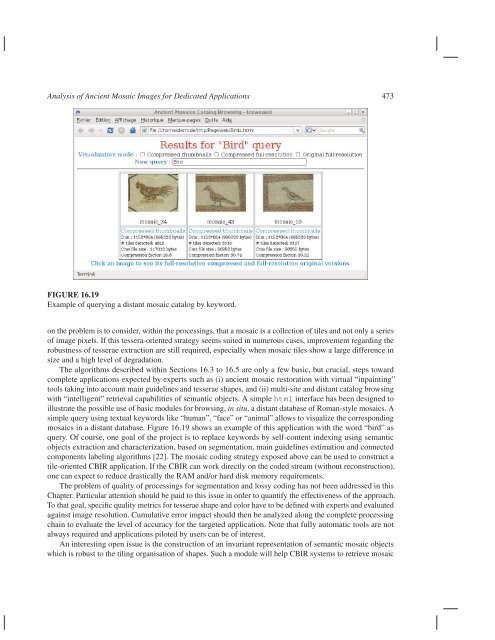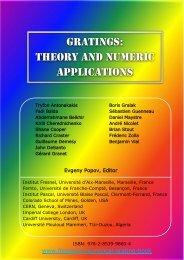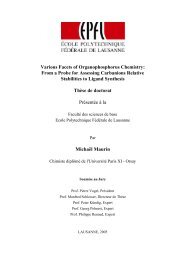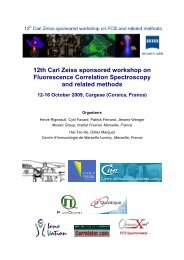Analysis of Ancient Mosaic Images for Dedicated ... - Institut Fresnel
Analysis of Ancient Mosaic Images for Dedicated ... - Institut Fresnel
Analysis of Ancient Mosaic Images for Dedicated ... - Institut Fresnel
Create successful ePaper yourself
Turn your PDF publications into a flip-book with our unique Google optimized e-Paper software.
<strong>Analysis</strong> <strong>of</strong> <strong>Ancient</strong> <strong>Mosaic</strong> <strong>Images</strong> <strong>for</strong> <strong>Dedicated</strong> Applications 473<br />
FIGURE 16.19<br />
Example <strong>of</strong> querying a distant mosaic catalog by keyword.<br />
on the problem is to consider, within the processings, that a mosaic is a collection <strong>of</strong> tiles and not only a series<br />
<strong>of</strong> image pixels. If this tessera-oriented strategy seems suited in numerous cases, improvement regarding the<br />
robustness <strong>of</strong> tesserae extraction are still required, especially when mosaic tiles show a large difference in<br />
size and a high level <strong>of</strong> degradation.<br />
The algorithms described within Sections 16.3 to 16.5 are only a few basic, but crucial, steps toward<br />
complete applications expected by experts such as (i) ancient mosaic restoration with virtual “inpainting”<br />
tools taking into account main guidelines and tesserae shapes, and (ii) multi-site and distant catalog browsing<br />
with “intelligent” retrieval capabilities <strong>of</strong> semantic objects. A simplehtml interface has been designed to<br />
illustrate the possible use <strong>of</strong> basic modules <strong>for</strong> browsing, in situ, a distant database <strong>of</strong> Roman-style mosaics. A<br />
simple query using textual keywords like “human”, “face” or “animal” allows to visualize the corresponding<br />
mosaics in a distant database. Figure 16.19 shows an example <strong>of</strong> this application with the word “bird” as<br />
query. Of course, one goal <strong>of</strong> the project is to replace keywords by self-content indexing using semantic<br />
objects extraction and characterization, based on segmentation, main guidelines estimation and connected<br />
components labeling algorithms [22]. The mosaic coding strategy exposed above can be used to construct a<br />
tile-oriented CBIR application. If the CBIR can work directly on the coded stream (without reconstruction),<br />
one can expect to reduce drastically the RAM and/or hard disk memory requirements.<br />
The problem <strong>of</strong> quality <strong>of</strong> processings <strong>for</strong> segmentation and lossy coding has not been addressed in this<br />
Chapter. Particular attention should be paid to this issue in order to quantify the effectiveness <strong>of</strong> the approach.<br />
To that goal, specific quality metrics <strong>for</strong> tesserae shape and color have to be defined with experts and evaluated<br />
against image resolution. Cumulative error impact should then be analyzed along the complete processing<br />
chain to evaluate the level <strong>of</strong> accuracy <strong>for</strong> the targeted application. Note that fully automatic tools are not<br />
always required and applications piloted by users can be <strong>of</strong> interest.<br />
An interesting open issue is the construction <strong>of</strong> an invariant representation <strong>of</strong> semantic mosaic objects<br />
which is robust to the tiling organisation <strong>of</strong> shapes. Such a module will help CBIR systems to retrieve mosaic













